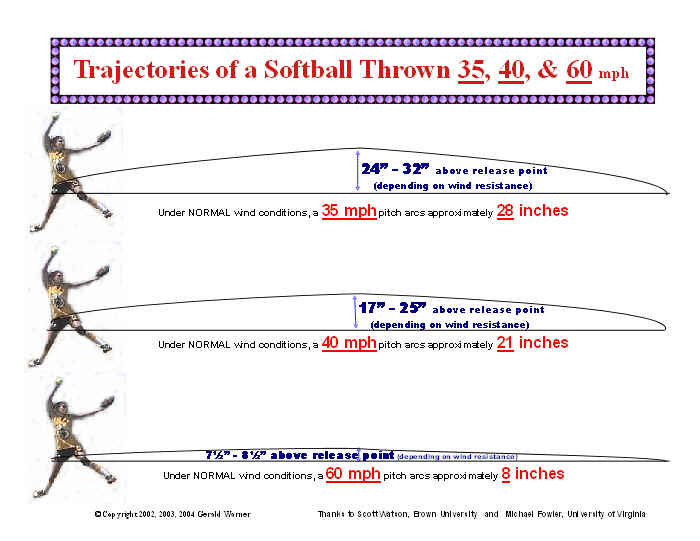|
by Gerald Warner, Softball Pitching
Instructor

No pitch...not even the
fastest fastball...is thrown on an absolutely level
line. ALL pitches, regardless of how fast they are
thrown, have an "arc" in them. And, change-ups and
other off-speed pitches can have quite a dramatic
arc.
It's gravity that
pulls the ball toward the ground no matter how fast they are thrown
forward. If you are a student of physics you might know
that the up and down curved path that the ball takes is called a
"parabolic arc". Since gravity's downward pull remains
constant, the height of this arc depends largely on:
(1) the speed (velocity)
that the ball is thrown, (2) the
distance that the ball will travel, (3)
the angle at which the ball is release, and (4) wind resistance.
________________________________________________________________________
Although these factors are
meaningful for EVERY pitch, the three pitches that are most directly
affected by this arc are:
FAST BALL - As you can see below, even though a 60 mph
fastball seems like it is coming in on a pretty level line,
it goes up...then down...as much as 8 inches in the time that it
takes to get from the pitcher's hand to the
plate.
RISE BALL - We mentioned in another section of
this website that a rise ball needs to be thrown in the low to
mid-50's before the backwards spin can have enough effect to
actually make the ball go UP. In the diagram
below, you can see that a rise, even thrown at 60 mph has to has
enough spin to overcome an 8-inch gravity-induced arc...JUST TO
LEVEL OUT! The release and speed of the spin has
to be even better to make it hop over the bat.
CHANGE-UP - We have seen a majority of
pitchers throwing their change-up too fast, because
they (or their coach) wanted
the ball to come in on a level line. Obviously, we
do NOT advocate a huge arc on a change-up (that's what slow-pitch softball pitching is all
about). As we
mentioned in another part of this website, we work with pitchers to
(1) make the change-up LOOK deceptive, and (2) to come in at a speed
25% to 35% slower than their fastball. That means
that a younger pitcher with a 50 mph fastball would want a change-up
of about 35 mph or so. A 55 to 58 mph fastballer works
well with a 40 mph change-up.
In the example shown below,
a pitcher wanting to throw a 35 mph change-up should try to throw it
so the highest point of the pitch is about equal to the level of her
shoulders.
A pitcher with a 40 mph
change would see the top of the arc about chest
high.

Since wind
resistance is a factor, remember that if the wind is coming in from
the pitcher's back (blowing toward home
plate) the ball will be more level
than is shown in the above diagrams . If the wind
is blowing in from the catcher's back, the ball has to be
thrown faster or needs a higher arc to reach the
target.
The article
above can be downloaded and printed from Microsoft Word

If you have questions or need more
information
E-mail us, or call Pitching Instructor Gerald Warner in
Colorado at (720)
200-4575
| 













